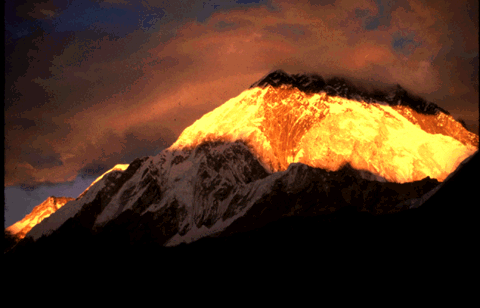Kiddies' Korner
( .. the language of plates, .. as used in Plate Tectonics .. )
Nope. Plates don't "move". Not the way Plate Tectonics says anyway, to "collide and build mountains". And if the crust /continent on top does, then so what?
The crust on top is not a plate, and may 'move' for reasons other than 'Plate Tectonics'.

Fig.1. Caterpillar tracks. Just because its trax are churning like billy-o doesn't mean this baby is going anywhere. .. just round-and-round like the lithospheric plate of Plate Tectonics. It's stuck in mud. No way can it even make it to the edge of the page to "collide" with and "crumple" another plate'. So plate *movement* as Plate Tectonics needs it to be, to "build mountains", is a non-starter. When it comes to "crumpling", *PLATES* simply don't "move". Not according to Plate Tectonics use of the language anyway. Convection cells don't move any more than an escalator might move out from the shop on to the street to "collide" with buildings. And if they're "moving" on the spot then they ain't goin' no-where - much less 'drfting /gliding /diving /riding /smashing /banging /bumping or travelling across the world to collide with other 'plates' (and build mountains).
Google search
|
"plates move" + tectonics
~2006 2017
|
| "Plates move" |
6,770 201,000 |
| "plates collide |
3,800 74,100 |
| "plates slide |
2,430 58,500 |
| "plates converge" |
1,630 69,300 |
| "plates float" |
1,170 28,100 |
| "plates drift" |
624 19,000 |
| "plates dive" |
624 1,020 |
| "plates ride" |
637 2,490 |
| "plates grind" |
600 22,000 |
| "plates crash" |
423 12,500 |
| "plates crunch" |
107 371 |
| "plates creep" |
798 287 |
| "plates glide" |
148 670 |
| "plates jostle" |
78 1,240 |
| "plates slam" |
198 319 |
| "plates ram" |
error 216 |
| "plates smash" |
error 3,800 |
| "plates bang" | lost 139 |
| "plates bump" |
2,940 (2012-10-17) 1,510 |
| "plates travel" |
936 1,090 |
| "plates migrate" |
2,440 706 |
("plates scurry")
| Did not match any documents (no legs!) |
And the language that *
should* be used (something like "cycling") (for convection) - or even 'convect' itself, is not used.
Plates don't do any of the above verbs (not even "scurry") (so they win one on that score at least). So Plate Tectonics runs foul of semantics again (repeat
link). All the words used are words of *
translation*, which convey a completely wrong meaning of "plate movement" - particularly when it comes to the
Origin of Mountains.
Fig.2. One for that dinner table conversation - Plate movement according to the lingo of Plate Tectonics. If a plate with dinner on it collides with another plate (with dinner on it), then the dinners heap up around the collision ("/crashing /crumpling /creeping) .. (jostling /smashing /ramming /bashing"), .. while one of the plates slides /glides beneath the other.
Well, .. it's what
they say, .. not me. Do me a favour and tell me if that image is basically your
understanding of "plate movement" according to the liturgy.) We can
cuddle each other for support in this post-Trumpian apocalyptic
/apoplectic Armageddon we're headed for.
====================
[20180609]
I sketched that figure after listening to two programs today, 1 :
Universities and private money and 2
Bespoke bodies (from about 29mins on the second one for the general overview), in order to highlight the question, how can such practical medical research co-exist with such dopey nonsense as Plate Tectonics? Somebody tell me it's me that's the dope (I don't mind), because the alternative is unthinkable, except that it is (thinkable). Unfortunately. Eventually it will be shrugged off as "the way science moves forward", but before that happens the parlous state of Plate Tectonics should be recorded for posterity. It should not be allowed to slip under the radar and be forgotten about without being held to account, with which in mind the
BBC science /Earth department got noticed for its take on "colliding plates building mountains". [The link on that twitterpost has moved b.t.w. to
https://www.bbc.co.uk/programmes/p00fzsnd ]
However, its reference to the wikipedia appears to be a disclaimer of sorts apologising for the clips being possibly factually incorrect, and suggesting some correction may be needed.
It's true. They do.
The Wikipedia is in a bit of a bind on that score, being skewered on the
semantics of "mountain formation" v. "mountain building", which difference highlights something of the trap that Plate Tectonics has fallen into with its tectonics of crustal crumpling. Fine, if primary school is the intended level of pitch, but for anything more they need a slap on the wrist because
1. they are abusing the public's intelligence,
2. casting aspersions on Professor Ian Stewart's standing as a science communicator (the script is just a generic consensus view) and
3. knocking a hole in the public purse by taking him all the way to New Zealand to read it. The offending passages (about moving plates, continental collisions buckling the crust and building mountains) are highlighted :-
Fig.3. 'Plates', the washing up, and who's doing it, .. the 'boing-boing' of plate collision (Fig.2 above)? .. or the gravitational instability of Earth expansion. A toss-up? (No that's not fair, .. just look at that mess on the left.) In the interest of order, peace and harmony, Earth expansion will volunteer.
=====================
.

















